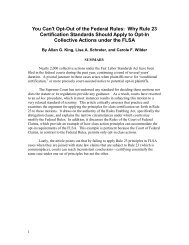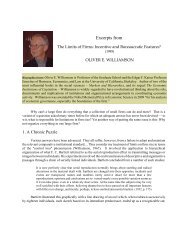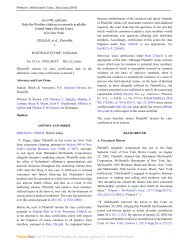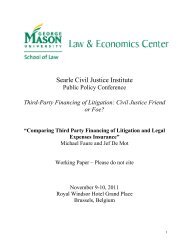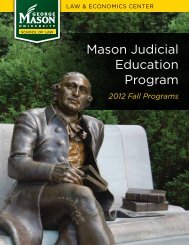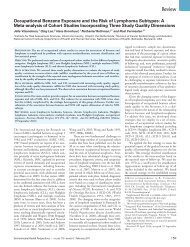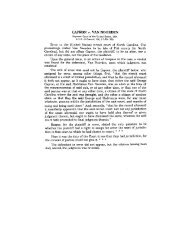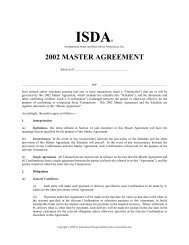Quoting Convention of NASDAQ Dealers Prompts a Justice ...
Quoting Convention of NASDAQ Dealers Prompts a Justice ...
Quoting Convention of NASDAQ Dealers Prompts a Justice ...
- No tags were found...
You also want an ePaper? Increase the reach of your titles
YUMPU automatically turns print PDFs into web optimized ePapers that Google loves.
<strong>Quoting</strong> <strong>Convention</strong> <strong>of</strong> <strong>NASDAQ</strong> <strong>Dealers</strong> <strong>Prompts</strong> a<strong>Justice</strong> Department ProbeMichael Baye and Patrick Scholten prepared this case study to serve as the basis forclassroom discussion rather than to represent economic or legal fact. The case is a condensed andslightly modified version <strong>of</strong> the public copy <strong>of</strong> the Complaint <strong>of</strong> Violation Statement, Civil Action No.96 CIV 5313, dated July 17, 1996 in the United States <strong>of</strong> America v. Alex Brown & Sons Inc., et al.<strong>NASDAQ</strong>The <strong>NASDAQ</strong> Stock Market, Inc. (<strong>NASDAQ</strong>) is the second largest securities market(measured by dollar value <strong>of</strong> trading) in the United States. <strong>NASDAQ</strong> market makers have<strong>of</strong>fices in various states. Their market-making activities, and the violation alleged, affectinvestors located throughout the United States. During the time period covered, thecompanies in question have traded substantial numbers <strong>of</strong> shares <strong>of</strong> <strong>NASDAQ</strong> stock acrossstate lines in a continuous and uninterrupted flow <strong>of</strong> interstate trade and commerce. Theactivities <strong>of</strong> each company as described here have been within the flow <strong>of</strong>, and havesubstantially affected, interstate commerce.POTENTIAL VIOLATIONThe companies in question are major "market makers" in <strong>NASDAQ</strong> stocks. Marketmakers establish their <strong>NASDAQ</strong> quotes in a particular stock by simultaneously quotingprices at which they are willing to buy and sell particular <strong>NASDAQ</strong> stocks. The quote atwhich an individual market maker is willing to buy a particular stock is known as its "bid";the quote at which it is willing to sell is known as its "ask." A market maker’s bid is alwayslower than its ask, and the difference between the two is known as its "dealer spread."There are at least two market makers in each <strong>NASDAQ</strong> stock. These market makersare purportedly independent and purportedly compete against other market makers, by,among other ways, quoting bid and ask prices on <strong>NASDAQ</strong> for particular stocks.The market maker’s bid- and ask-prices are organized and displayed on <strong>NASDAQ</strong>’scomputerized quotation system. The market makers use this computer system to change andupdate their respective bid and ask prices and to continuously communicate their prices to theother market makers in particular stocks.At any given time, one or more than one market maker may have the best bid or askprice in a particular stock on <strong>NASDAQ</strong>. The highest bid price is known as the "inside bid";the lowest ask price is known as the "inside ask." The difference between the "inside bid"(the highest price <strong>of</strong>fered by any market maker to buy that stock) and the "inside ask" (thelowest price <strong>of</strong>fered by any market maker to sell that same stock) is referred to as the "insidespread."Managerial Economics and Business Strategy, 7e Page 1
Market makers earn money from the difference between the bid and ask, or the insidespread. Market makers therefore have an incentive to maintain wider inside spreads in<strong>NASDAQ</strong> stocks than would exist in a competitive market. The width <strong>of</strong> the inside spread ina stock has a direct impact on investors in <strong>NASDAQ</strong> stocks. The wider the inside spread, thegreater the transaction costs for buying and selling <strong>NASDAQ</strong> stocks.Beginning at least as early as 1989, a common understanding might have aroseamong the companies listed in Appendix A companies and other <strong>NASDAQ</strong> market makersconcerning, among other things, the manner in which bid and ask prices would be displayedon <strong>NASDAQ</strong> (the "quoting convention"). Under the quoting convention, stocks with a dealerspread <strong>of</strong> 3/4 point or greater are quoted in even-eighths (quarters). Under the quotingconvention, market makers use odd-eighth fractions in their bid and ask prices only if theyfirst narrow their dealer spread in the stock in question to less than 3/4 <strong>of</strong> a point.The listed companies and other market makers may have reached a commonunderstanding to adhere to the quoting convention. This understanding is evidenced by,among other things, the following facts:a. For a significant number <strong>of</strong> major stocks traded on <strong>NASDAQ</strong>, all <strong>of</strong> whichhave prevailing dealer spreads <strong>of</strong> 3/4s <strong>of</strong> a point or greater, there has been analmost complete absence <strong>of</strong> bid or ask price quotes in odd-eighths;b. The companies here and other market makers have used and continue to usepeer pressure to ensure compliance with the common understanding bymaking it known throughout the industry that it is "unethical" or"unpr<strong>of</strong>essional" for a market maker to "break the spread" by using odd-eighthquotes in stocks with dealer spreads <strong>of</strong> 3/4s <strong>of</strong> a point or greater and byaccusing market makers who do so <strong>of</strong> "making a Chinese market";c. The companies here and other market makers have taken actions to enforcecompliance with the common understanding and to coerce non-complyingmarket makers to adhere to the common understanding by, among otherthings, making telephone calls to market makers who have violated thequoting convention or narrowed the inside spread;d. The companies here and other market makers have threatened to refuse, andrefused, to deal with traders and firms that have violated the quotingconvention;e. Absent a common understanding, it would not have been in the economicself-interest <strong>of</strong> the companies and other market makers to narrow their dealerspreads below 3/4s <strong>of</strong> a point as a condition <strong>of</strong> being able to adjust their bidand ask prices in odd-eighths, as a narrower dealer spread imposes a greatereconomic risk to market makers;f. Absent a common understanding, there are numerous instances in which itwould have been in the economic self-interest <strong>of</strong> market makers freelycompeting with one another to maintain a dealer spread <strong>of</strong> 3/4s <strong>of</strong> a point orPage 2Michael R. Baye
greater and yet have improved their bid or ask prices by 1/8 <strong>of</strong> a point, ratherthan by 1/4 <strong>of</strong> a point;g. Confronted by (1) widespread news reports <strong>of</strong> an academic study thatindicated collusion in the <strong>NASDAQ</strong> market, and (2) a major and continuinginvestigation by the Antitrust Division <strong>of</strong> the Department <strong>of</strong> <strong>Justice</strong>, thecompanies here and other market makers have altered their quoting practicesby using odd-eighth increments for bid and ask quotes in some stocks wheresuch increments were previously avoided. This abrupt change in behaviorcannot be explained by any reduction in the above companies’ costs <strong>of</strong> doingbusiness, nor by any change in market structure, trading strategy, or thefundamentals <strong>of</strong> the underlying stocks; andh. Market makers, including the companies here and others, frequently have usedand continue to use an electronic trade system known as Instinet on which tobuy and sell, at odd-eighth prices, the same <strong>NASDAQ</strong> stock that they havequoted and continue to quote only in even-eighth prices on <strong>NASDAQ</strong>. Thefact that these companies have used and continue to enter orders to buy andsell <strong>NASDAQ</strong> stocks at prices quoted in odd-eighths on a proprietary tradingsystem that is comparable to <strong>NASDAQ</strong> shows that the absence <strong>of</strong> odd-eighthquotes on <strong>NASDAQ</strong> is not the result <strong>of</strong> any fundamental attributes <strong>of</strong> thosestocks and is evidence that the quoting convention has operated and continuesto operate on <strong>NASDAQ</strong> to keep the inside spread in numerous <strong>NASDAQ</strong>stocks at 1/4 point or greater.MARKET IMPACTThe purpose and effect <strong>of</strong> the potential quoting convention has been to raise, fix, andstabilize the inside spread on a substantial number <strong>of</strong> <strong>NASDAQ</strong> stocks at a minimum <strong>of</strong> 1/4point. The quoting convention has potentially had the following effects, among others:1. price competition among the companies in question in the purchase and sale<strong>of</strong> <strong>NASDAQ</strong> securities might have been restrained;2. investors who have purchased or sold <strong>NASDAQ</strong> securities might have beendeprived <strong>of</strong> the benefits <strong>of</strong> free and open competition in the purchase and sale<strong>of</strong> <strong>NASDAQ</strong> securities; and3. the inside spread on a substantial number <strong>of</strong> <strong>NASDAQ</strong> stocks has possiblybeen wider than it would have been in a competitive market, resulting inhigher transaction costs for buying and selling <strong>NASDAQ</strong> stocks.Managerial Economics and Business Strategy, 7e Page 3
APPENDIX A: List <strong>of</strong> Companies Involved in the SuitALEX. BROWN & SONS INC.BEAR, STEARNS & CO., INC.CS FIRST BOSTON CORP.DEAN WITTER REYNOLDS, INC.DONALDSON, LUFKIN & JENRETTE SECURITIES CORP.FURMAN SELZ LLCGOLDMAN, SACHS & CO.HAMBRECHT & QUIST LLCHERZOG, HEINE, GEDULD, INC.J.P. MORGAN SECURITIES, INC.LEHMAN BROTHERS, INC.MAYER & SCHWEITZER, INC.MERRILL LYNCH, PIERCE, FENNER & SMITH, INC.MORGAN STANLEY & CO., INC.NASH, WEISS & CO.OLDE DISCOUNT CORP.PAINEWEBBER INC.PIPER JAFFRAY INC.PRUDENTIAL SECURITIES INC.SALOMON BROTHERS INC.SHERWOOD SECURITIES CORP.SMITH BARNEY INC.SPEAR, LEEDS & KELLOGG, LPUBS SECURITIES LLCPage 4Michael R. Baye




